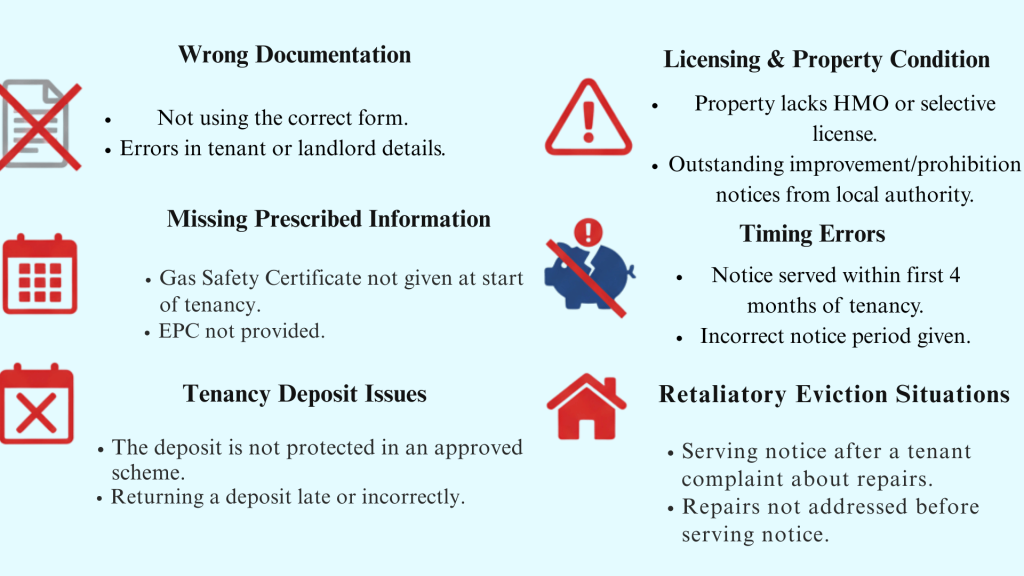One simple mistake on a Section 21 notice can cost you months of delays and hundreds of pounds in legal fees.
Courts reject thousands of possession claims every year because landlords use the wrong form, miss deadlines, or fail to protect deposits properly.
But here’s what most property guides don’t explain: even experienced landlords fall into the same traps repeatedly.
This guide breaks down exactly what makes Section 21 notices fail in court and shows you how to get it right the first time.
We’ll cover the legal requirements, common mistakes that void notices, and practical steps to ensure your documentation withstands scrutiny.
Whether you’re serving or receiving a Section 21, you’ll learn how to protect your rights and avoid costly legal battles.
What is a Section 21 Notice?
A Section 21 notice is a legal document that allows landlords to end assured shorthold tenancies without providing any reason.
Created under the Housing Act 1988, it’s often referred to as a “no-fault eviction” notice because you don’t need to prove that your tenant did anything wrong.
You can use Section 21 to regain possession of your property after the fixed term ends, but there are strict rules about when you can serve it.
You cannot use this notice during the first four months of a tenancy if you haven’t met certain legal requirements, like protecting the deposit, or if there are outstanding property issues.
Think of it as your legal tool to end a tenancy – but only when you’ve followed all the rules correctly.
Legal Framework & Key Requirements
The law sets out clear rules every landlord must follow before serving a Section 21 notice.
- Minimum notice period: You must give at least two months’ notice, and it cannot expire before the fixed term ends.
- Correct form: Use Form 6A for assured shorthold tenancies – any other form will make your notice invalid.
- Who can serve it: Only the landlord or their authorized agent can legally serve a Section 21 notice to tenants.
- Serving methods and deadlines: Serve by hand, recorded delivery, or email (if agreed), ensuring the tenant receives it before the notice period starts.
Mistakes That Make a Section 21 Notice Invalid

Even small errors can make a Section 21 notice legally invalid. From missing documents to wrong dates, these mistakes often delay or derail eviction claims.
1. Wrong Documentation
Using the wrong form is the fastest way to lose your case in court. Many landlords still use outdated forms or generic templates they found online.
Get this wrong, and your notice becomes worthless. Always double-check tenant names, your details as landlord, property addresses, and tenancy start dates before serving.
2. Missing Prescribed Information
You cannot serve a valid Section 21 if you haven’t given tenants their required documents first.
This includes a current Gas Safety Certificate, an Energy Performance Certificate, and the latest “How to Rent” guide. Miss any of these at the start of the tenancy and your Section 21 will fail.
The government updates the “How to Rent” guide regularly, so ensure you have the most current version.
3. Tenancy Deposit Issues
Your tenant’s deposit must be protected in an approved scheme within 30 days of receiving it. You must also provide the prescribed information about deposit protection within this timeframe.
If you’ve handled the deposit incorrectly or returned it late, you cannot serve a valid Section 21. Courts take deposit protection very seriously and will reject notices from landlords who are not compliant.
4. Licensing & Property Condition
Properties requiring HMO or selective licensing must have valid licenses before you can serve Section 21.
Outstanding improvement notices or prohibition notices from your local council also block your right to serve. Check with your local authority to determine the licensing requirements in your area.
Some councils have additional licensing schemes that could affect your property.
5. Timing Errors
You cannot serve Section 21 during the first four months of any tenancy period. The notice period must be at least two months, and it cannot expire before the fixed term ends.
Many landlords miscalculate the expiry date or serve notices too early. Count your dates carefully and consider seeking legal advice if you’re unsure about timing.
6. Retaliatory Eviction Situations
Serving Section 21 after a tenant complains about repairs can appear to be retaliation and is often deemed invalid.
If tenants have reported health and safety issues that remain unaddressed, courts may refuse your possession claim. Address all legitimate repair requests before considering eviction.
Keep detailed records of all maintenance work and tenant communications to protect yourself.
Steps to Ensure a Section 21 Notice is Valid
Landlords can avoid costly setbacks by thoroughly reviewing and double-checking legal requirements. A simple checklist helps ensure the Section 21 notice stands up in court.
- Use the correct form (Form 6A):Download the official Form 6A from the government website; don’t rely on outdated versions or templates. Using any other form will automatically make your notice invalid and waste months of your time. (Click here to read NOTES FOR FORM 6A)
- Double-check names, dates, and addresses: Spelling mistakes in tenant names or wrong property addresses can void your entire notice. Check every detail twice before serving, including middle names and apartment numbers.
- Ensure all prescribed documents are provided: Give tenants their Gas Safety Certificate, Energy Performance Certificate, and current “How to Rent” guide before the tenancy starts. Without these documents, you cannot serve a valid Section 21 notice later.
- Confirm deposit compliance: Protect the deposit in an approved scheme within 30 days and serve the prescribed information immediately. Keep copies of all deposit protection paperwork as proof of compliance.
- Ensure property licensing is in order: Check if your property requires HMO or selective licensing with your local council. Any missing licenses or outstanding council notices will completely block your Section 21 rights.
- Serve notice only after the first four months of tenancy: Wait until at least four months have passed since the tenancy began before serving Section 21. This rule applies to every new tenancy period, not just the original agreement.
- Provide correct notice period and confirm expiry date: Give at least two months’ notice and ensure it doesn’t expire before the fixed term ends. Calculate the expiry date carefully – count months, not days, from the service date.
- Keep records of when and how the notice was served: Document exactly when and how you served the notice with photos, receipts, or witness statements. Courts require clear evidence that proper service was completed within the prescribed timeframes.
Consequences of Serving an Invalid Section 21 Notice
An invalid Section 21 notice can waste time, add costs, and even strengthen a tenant’s position in court.
| Consequence | Details |
|---|---|
| Court rejection | The judge may dismiss the case if the notice is invalid. |
| Extra costs | Landlords face new court fees, legal costs, and delays. |
| Tenant claims | Tenants may challenge the notice or claim compensation. |
| Relationship damage | Invalid notices can strain trust and communication. |
What Tenants Should Do with a Section 21 Notice
If you get a Section 21 notice, don’t panic, check if it’s valid first. Review the form used (it should be Form 6A) to verify that all names and dates are correct.
Confirm that your landlord provided you with the Gas Safety Certificate, EPC, and “How to Rent” guide at the start of your tenancy.
Verify that your deposit was properly protected and that the notice was served within the first four months.
You have legal rights and possible defenses, especially if the landlord failed to meet their obligations or if this feels like retaliation for repair complaints.
Get free advice immediately from Shelter, Citizens Advice, or legal aid services; they can help you understand your options and challenge invalid notices in court.
Disclaimer: This article is for general information only and is based on guidance from official UK government sources. Always check the latest updates on GOV.UK or seek professional legal advice before taking action.
Conclusion
Getting Section 21 notices right isn’t optional; it’s essential for landlords who want to avoid costly court rejections and months of delays.
One missing document or timing error can void your entire notice, leaving you stuck with problem tenants and mounting legal bills.
The good news? Following the checklist we’ve outlined, you are protected from the most common mistakes that trip up thousands of landlords every year.
For tenants, knowing your rights means you won’t be pushed out illegally or intimidated by invalid notices.
Check every detail, understand your protections, and don’t hesitate to challenge notices that don’t meet legal requirements.
Ready to protect yourself? Bookmark this guide, download the official Form 6A, and get professional advice if you’re unsure about any requirements.














